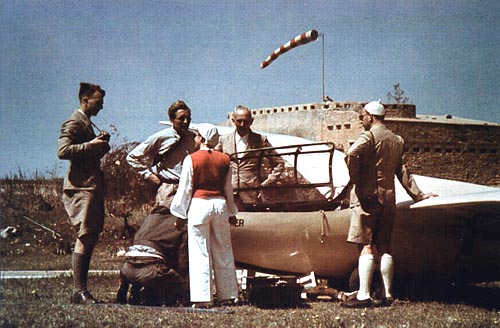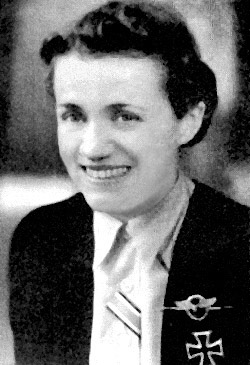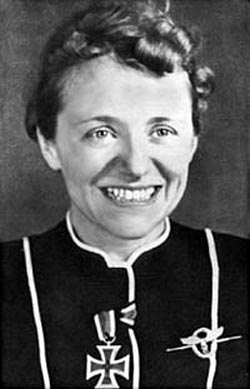Hanna Reitsch

Hanna Reitsch (March 29, 1912 - August 24, 1979) was a famous World War II German test pilot, and a favorite of the upper echelon of the Nazi party.
Hanna was born the daughter of an ophthalmologist and was in training to become a medical doctor in 1932 when she left that field to pursue a career as a test pilot. In the 1930s she became fairly famous, setting many glider aerobatic and endurance records, being the first woman to fly the Alps in a glider, and was rather photogenic. Several of her gliding records stand to this day.

Rare colour photo of Hanna Reitch, Libya, 1939 (tbc)
In 1937 she was posted to the Luftwaffe testing center at Rechlin by Ernst Udet. While under direct command of Karl Franke she soon became a major test pilot on the Junkers Ju 87 Stuka and Dornier Do 17 projects, as well as one of the few to fly the new Focke-Achgelis Fa 61, the world's first helicopter. This made her a star of the Nazi party, always looking for publicity, and in 1938 she flew the Fa 61 every night inside the arena of the Berlin Motor Show.
As the war progressed, Reitsch was invited to fly many of Germany's latest designs, including the Messerschmitt Me 163 Komet, and several larger bombers on which she tested various mechanisms for cutting barrage balloon cables. Eventually she became Adolf Hitler's favorite pilot. She survived many accidents and was heavily hurt several times.
She worked fervently and methodically in a cause she accepted without question. In 1941, Hitler awarded her the Iron Cross, second class, for the almost fatally dangerous work she did in developing means for cutting the cables dangled by British barrage balloons. The most dangerous machine she tested was the Messerschmitt 163, Germany's experimental rocket-powered interceptor. In a minute and a half after takeoff it climbed at a 65-degree angle to 30,000 feet. It traveled 500 mph -- the fastest any human had ever gone.
On her fifth flight, the takeoff dolly jammed. She crash- landed, split her face open, and still had the presence of mind to write out what'd happened before she passed out. She spent the next four months hovering between life and death; and, this time, Hitler gave her the Iron Cross, first class.

Near the end of the war she became involved in testing the V-1 Flying Bomb, which was fitted with a cockpit in order to be used during gliding tests, dropped from a Heinkel He 111 bomber. Later it was suggested that similarly equipped V-1 would be used as point-attack weapons by members of KG 200. Although a number of V-1's were so equipped as Reichenbergs, they were never used in combat.
In the last days of the war Reitsch was asked to fly her lover, General Robert Ritter von Greim, into Berlin to meet with Hitler. The city was already surrounded by Red Army troops who had made significant progress into the downtown area when they arrived on the 27th, landing on a city street, and traveled to the "bunker". She is said to have overheard Hitler laying out plans for Nazi commanders to join together in mass suicide when it was obvious that the war was over. She also hoped to fly out the children of propaganda minister Joseph Goebbels, who'd been living there with their parents, but he would not allow it. She escaped Berlin through heavy Russian anti-aircraft fire.
Held for 18 months by the American military after the war, she was interrogated and then released.

After the war German citizens were forbidden from flying, except, after a few years, in gliders. In 1952 Hanna Reitsch won third place in the world gliding championship in Spain (and was the only woman who competed).
In 1959 she was invited to India by the Indian Prime Minister Jawaharlal Nehru, where she founded a sports gliding network. In 1961 she was invited by President John F. Kennedy to the White House.
From 1962 to 1966 Reitsch resided in Ghana, where she founded and ran a gliding school. In the 1970s she broke many records in several categories.
After the war she was doggedly unrepentant. She wore her Iron Crosses proudly and wrote somewhat defensive and self-serving memoirs. At the age of 65, two years before she died of a heart attack, she set a new women's distance record in a glider.
|
|
 |
Primary Source: Wikipedia, the free encyclopedia
![]()
© Copyright Wehrmacht-Awards.com LLC |

